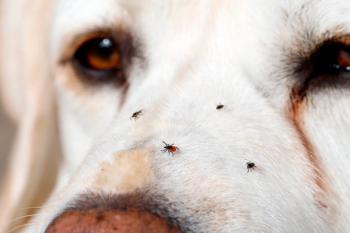
Tick-borne diseases: Lyme borreliosis and anaplasmosis (Proceedings)
Testing for Lyme disease and anaplasmosis often involves detection of antibodies. Antibodies may be detected on a patient-side assay such as the 3Dx/4Dx SNAP tests or using IFA at a reference lab. The SNAP test uses C6 as the target antigen and thus the B. burgdorferi result is very specific.
Interpreting test results for agents of Lyme borreliosis and anaplasmosis
Testing for Lyme disease and anaplasmosis often involves detection of antibodies. Antibodies may be detected on a patient-side assay such as the 3Dx/4Dx SNAP tests or using IFA at a reference lab. The SNAP test uses C6 as the target antigen and thus the B. burgdorferi result is very specific. Only antibodies to wild-type B. burgdorferi will be detected and there is no reaction (no false positives) in vaccinated dogs in the absence of exposure. Because vaccines are not 100%, vaccinated dogs that are exposed to wild type organisms in nature may still seroconvert, and a low level of antibodies indicating exposure but not necessarily disease may result in a positive test. Positive SNAP tests for B. burgdorferi should be followed up with a quantitative C6 assay to determine the level of antibody present. If significant and if clinical disease is present, then treatment is indicated. In a seropositive dog with no evidence of clinical disease, a urinalysis can be performed to determine if proteinuria is present, which could suggest that Lyme nephritis may be developing. However, approximately half of all positive dogs in endemic areas will have significant levels of antibody. In non-endemic or very low-endemic areas like the southeastern US, the majority of B. burgdorferi SNAP-positive dogs have levels of antibody below that considered clinically relevant.
A positive result on the A. phagocytophilum component of the 3Dx/4Dx assay also indicates that antibodies are present, and thus infection, but not necessarily disease, has occurred. There is not a direct follow-up quantitative assay for SNAP-positive A. phagocytophilum samples as there is for B. burgdorferi positives. Thus, when positives occur, a complete blood count with platelet count should be performed. If a low platelet count is present then treatment is indicated; treatment should also be pursued in any dog with clinical signs of anaplasmosis. The A. phagocytophilum analyte is less specific than that targeting B. burgdorferi; for example, a positive may be generated on the A. phagocytophilum spot when exposure to A. platys has occurred. Regardless of the cause of antibody production, positives do indicate that there has been a breach in the tick control program and that the dog is being bitten by ticks and at risk of contracting a tick-borne disease.
Other tests for tick-borne diseases include immunofluorescent antibody assays (IFA), polymerase chain reaction, examination of stained blood smears, and culture. The IFA tests are less specific than the patient side 3Dx/4Dx tests. However, IFAs can be performed quantitatively to determine a titer and sequentially to detect a change in titer, thus suggesting a recent, active infection that requires treatment. Positives for B. burgdorferi on IFA must be followed by a Western blot to both confirm the antibodies detected are indeed to B. burgdorferi and to distinguish from vaccine antibodies; for this reason, the more specific C6 testing is largely preferred to IFA for diagnosis of Lyme disease. Testing by PCR, which detects DNA of causative agents, can be quite useful to diagnose acute ehrlichiosis or anaplasmosis, so long as circulating organisms are present. Because B. burgdorferi is not present in circulation, PCR testing of whole blood is not used to diagnose Lyme disease. Anaplasmosis can also be diagnosed by finding morulae within neutrophils and occasionally eosinophils on stained blood smears. However, a negative result on PCR or blood smear examination does not rule-out the possibility of infection. Culture can be performed on skin biopsy or joint synovium (B. burgdorferi) or buffy coat (A. phagocytophilum) but is challenging and largely reserved for specialized research laboratories.
Geographic distribution of Lyme borreliosis and anaplasmosis
Lyme disease
Lyme disease is commonly recognized in both people and dogs in hyperendemic areas of the United States, which includes northeastern, upper midwestern, and West Coast states. Borrelia burgdorferi is the only etiologic agent of Lyme borreliosis identified in people or dogs in North America to date. The organism is maintained in nature through a cycle involving rodents, primarily white-footed mice, as reservoir host and Ixodes spp. ticks as vector. Infection is transmitted to people or dogs via the bite of nymphal or adult Ixodes spp. ticks that acquired the spirochetes when feeding on rodents as larvae or nymphs. Although Ixodes scapularis, the primary vector of Lyme disease in the eastern half of the US, is common in southern states, confirmed cases of Lyme disease in people or dogs are considered rare or non-existent in this region.
Anaplasmosis
Granulocytic anaplasmosis is a relatively recently recognized disease of both dogs and people in the United States caused by infection with Anaplasma phagocytophilum. Infection of dogs with A. phagocytophilum is common in areas where dogs are frequently parasitized by black-legged ticks (Ixodes spp.), such as the northeastern, midwestern, and West Coast states. Indeed, distribution of infection closely resembles that of Lyme disease as the two causative agents share a common maintenance cycle in nature; as with B. burgdorferi, rodents are considered the primary reservoir host for A. phagocytophilum and I. scapularis/I. pacificus ticks the major vector. However, A. phagocytophilum can infect a large variety of mammalian species, and other reservoir hosts may well be involved in creating a source of infection for ticks in nature. The geographic distribution of human anaplasmosis largely overlaps that of Lyme borreliosis, and most cases in the US are reported from the Northeast, upper Midwest, and West Coast states.
Clinical disease
Lyme borreliosis
The majority of dogs infected with B. burgdorferi do not appear to develop any overt clinical illness. Those dogs that do become ill may present with polyarthritis, fever, anorexia, and/or lymphadenopathy. Some chronically infected dogs go on to develop Lyme nephropathy, a glomerluonephropathy associated with B. burgdorferi infection for which the pathogenesis is unclear. Dogs with Lyme nephropathy do not respond well to treatment, and such cases are often fatal. Published evidence suggests B. burgdorferi may persist in dogs following antibiotic treatment; in one study, spirochetes were recovered in culture from dogs after antibiotic treatment. However, the significance of this finding is not clear because the presence of B. burgdorferi was not associated with clinical disease in those dogs.
Anaplasmosis
Dogs with anaplasmosis caused by A. phagocytophilum usually present with fever, depression, myalgia, anorexia, lameness, and thrombocytopenia. People with anaplasmosis report severe headaches. Fatalities can occur but are considered relatively uncommon. Infected dogs are most commonly found in the Midwestern US, where almost 7% of all dogs, and as many as 20-60% of dogs from individual counties, test positive. Infection is also common in dogs with the northeastern states and in California. Not surprisingly, evidence of co-infections with A. phagocytophilum and B. burgdorferi in dogs is commonly seen in endemic areas where the prevalence of both organisms is high. In a recent nationwide survey, over 40% of dogs from one county in Minnesota had antibodies to both A. phagocytophilum and B. burgdorferi.
Treatment and prevention of Lyme borreliosis and anaplasmosis
Current data indicate that both Borrelia burgdorferi and Anaplasma phagocytophilum are cycling in hyperendemic areas of the northeastern, upper Midwestern, and West Coast states. Routine screening for exposure to these organisms with appropriate subsequent laboratory tests to evaluate for presence of subclinical disease may be warranted in endemic areas. A 4-week course of doxycycline is recommended for treating both Lyme disease and anaplasmosis in dogs. However, repeated or extended treatment may be necessary in some refractory cases and re-infection from ticks in the environment can occur. Vaccines are only available for prevention of Lyme borreliosis in dogs. The efficacy of vaccination in preventing infection ranges from 50-85% in experimental challenges and to >90% in clinical situations. Accordingly, strict attention to tick control, in addition to vaccination in endemic areas when possible, remains the mainstay of preventing tick-borne disease in dogs.
Selected references (additional detailed references available upon request)
Bacon, R.M. et al. (2008) Surveillance for Lyme disease—United States, 1992-2006. MMWR Surveill. Summ. 57, 1-9
Bowman DD, Little SE, Lorentzen L, Shields J, Sullivan MP, Carlin EP. 2009. Prevalence and geographic distribution of Dirofilaria immitis, Borrelia burgdorferi, Ehrlichia canis, and Anaplasma phagocytophilum in dogs in the United States: results of a national clinic-based serologic survey. Vet Parasitol. 160:138-48.
Companion Animal Parasite Council Guidelines, Vector-borne Diseases.
Duncan AW, Correa MT, Levine JF, et al. 2004. The dog as a sentinel for human infection: prevalence of Borrelia burgdorferi C6 antibodies in dogs from southeastern and mid-Atlantic states. Vector Borne Zoonotic Dis. 4, 221–229.
Littman, M.P. et al. (2006) ACVIM small animal consensus statement on Lyme disease in dogs: diagnosis, treatment, and prevention. J. Vet. Intern. Med. 20, 422-434
Hutton, T.A. et al. (2008) Search for Borrelia burgdorferi in kidneys of dogs with suspected "Lyme nephritis" . J. Vet. Intern. Med. 22, 860-865
Wormser GP, Dattwyler RJ, Shapiro ED, et al. 2006. The clinical assessment, treatment, and prevention of Lyme disease, human granulocytic anaplasmosis, and babesiosis: clinical practice guidelines by the Infectious Diseases Society of America. Clin Infect Dis. 43(9):1089-134.
Newsletter
From exam room tips to practice management insights, get trusted veterinary news delivered straight to your inbox—subscribe to dvm360.






